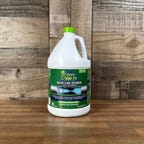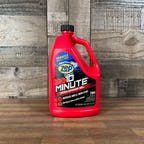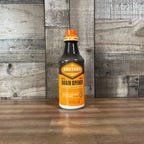Best Chemical Drain Cleaners for 2024
Chemical drain cleaners can be an effective way to clear blockages. We've tested the top brands in our lab; here are the winners.
Our Picks
When it comes to home maintenance, it's easy for the things we can't see, like plumbing issues and drain clogs, to go unnoticed until there's a problem. It's important to keep only the best chemical drain cleaners on hand in the event you encounter blockages, and you should educate yourself on how to stay safe while handling these products.
To shed light on the effectiveness of these controversial products, I leaned on my background as a chemical engineer and embarked on a simple yet revealing experiment. I took eight of the most commonly available chemical drain cleaners -- six alkaline and two acidic -- and subjected them to dissolution tests designed to evaluate how well they're each able to dissolve the aforementioned offending blockages. The objective was simple: to determine which products, if any, succeeded in disintegrating some of the most common clogging materials.
A couple of disclaimers to start things off. First, it's essential to acknowledge the prevailing stance among most reputable plumbers, who strongly advise against the use of chemical drain cleaners. Their concerns revolve around potential damage to our plumbing systems and the buildup of harmful fumes. These professionals emphasize the importance of preventive measures, regular maintenance and nonchemical alternatives as the best choice for most homes.
If you have been dealing with regular drain blockages, I encourage you to contact a plumber and ask for advice. Most of the time, blockages should be removed by mechanical means (such as a plumbing snake operated by a trained professional) and a thorough inspection is needed to determine the root cause for a long-term solution. If you've already used any type of chemical drain cleaner, you have to let your plumbing professional know in advance. Withholding this information can put someone's health and safety at risk, including yours.
All of that aside, and recognizing the ample availability and persistent usage of chemical drain cleaners, I undertook this evaluation to offer insight and guidance to those of you who may still consider them as an emergency exit. My goal is to equip you with the knowledge needed to make an informed choice. Now, let's play with some laboratory glassware and reveal the results.
Averaging $19 at the time of this publication, the Green Gobbler Main Line Opener emerged as the top performer in our batch dissolution test, excelling in almost every category. It successfully dissolved 100% of the pet hair, 78% of the organic compounds, 35% of the grease and 16% of the paper products. When mixed with water, the solution maintained a moderate level of basicity with a pH of 10.73, and it generated minimal heat, as evidenced by the negligible increase in water temperature after mixing (< 0.5 degrees Celcius).
One of its key ingredients is lauramine oxide, a surfactant that is resistant to bleach. This feature is particularly important because the Green Gobbler Main Line Opener doesn't rely solely on its bleach-lye mixture for dissolving and unclogging. A bleach-stable surfactant refers to a chemical substance that remains mostly unaffected by the presence of bleach while reducing the surface tension of the liquid in which it is dissolved; In this case, the water-drain cleaner solution mixture inside your drains.
Reducing the surface tension of a liquid offers several benefits, such as enhancing its spreading and wetting capabilities. In chemistry terms, spreading and wetting occurs when a liquid comes into contact with a solid, adhering to it and spreading evenly around it. This action promotes the formation of chemical bonds at the surface, and in the case of drain cleaner solutions, it effectively disintegrates and dislodges the clogging solid debris, restoring the smooth flow of water, chunk by chunk.
The Green Gobbler Main Line Opener offers versatility, claiming to be safe for use on various piping systems, including toilets, sinks, tubs, showers and even septic tanks. It is crucial to exercise extreme caution and carefully follow all instructions and safety recommendations provided.
Best cheap drain cleaner
Zep 10-minute Drain Opener Gel
The Zep 10-minute Drain Opener Gel is currently priced at $14, but it punched above its weight in our lab, performing remarkably well in our dissolution test. It effectively dissolved 70% of the hair, 80% of the organic matter and 15% of the grease, and showed the best performance in dissolving paper products, achieving a rate of 16%. That's terrific considering that it's just a bit more than half the cost of our overall winner for the category.
The chemical composition of this drain opener gel includes isopropanol and strong bases such as bleach, lye and caustic potash. When mixed with water, it resulted in a solution with the least alkalinity compared to other drain cleaners, measuring a pH of 8.49. We also observed a slight increase in water temperature of approximately 4 degrees C upon mixing.
Although the product claims to be safe for most piping systems, it's important to note that it is designed for rapid action, using only 16 ounces within a 10-minute timeframe as instructed. This rapid action leads to a moderate amount of heat generation, which may not be ideal for prolonged use. While it serves as a great emergency option, I would not recommend relying on this product long-term.
Best acidic drain cleaner
Santeen Sulfuric Acid Drain Opener
The Santeen Sulfuric Acid Drain Opener proved to be the most potent among all the chemical drain cleaners we tested, effectively dissolving 80% of the hair, 80% of the organic matter, 40% of the grease and 76% of the paper products. When combined with water, it creates a highly acidic solution with a pH of 1.59, roughly the same acidity as the gastric fluids in your stomach. For additional safety considerations, please refer to the section below on how we test chemical drain cleaners.
A six-pack of 32-ounce bottles of this concentrated sulfuric acid cleaner is currently priced at $60. Considering that the instructions typically recommend using only half the bottle, it offers excellent value for your money.
While the product claims to be safe for septic tanks and drain fields, it's important to note that, due to its strongly acidic and corrosive nature, it is not safe to use on any metal or porcelain surfaces.
Please exercise extreme caution when using this product and carefully follow all instructions and safety recommendations provided on the bottle.
How we test chemical drain cleaners
For this rundown, I headed to CNET's product testing lab in Louisville, Kentucky to conduct a comprehensive batch distillation experiment with eight of the most commonly used chemical drain cleaners on the market. My primary objective was to determine the efficiency of each product in dissolving various types of clogging materials, including organic matter, grease, paper products and pet hair (the same pet hair we use for our robot vacuum tests, as a matter of fact). Throughout the experiment, I also noted the pH levels of the cleaning solutions when mixed with water and monitored any temperature changes. Furthermore, I considered the chemical composition and versatility of use of each product when comparing them to one another.
Acids vs. bases
Before conducting experiments with these substances, I separated them into acids and bases. As you may recall from high school chemistry, acids are compounds that donate a hydrogen ion (H+) when mixed with water and have a pH lower than 7. On the other hand, bases are compounds that accept those ions (or hydroxide, OH- ions) and have a pH higher than 7. Understanding this distinction is crucial, due to two important factors associated with these products: corrosivity and causticity.
Corrosivity refers to the potential of a chemical substance to cause rust and deterioration of the materials that make up your piping system. Causticity, on the other hand, relates to how a chemical substance reacts when it comes into contact with organic matter, specifically breaking down proteins and other organic molecules, which can lead to tissue destruction or chemical burns.
To determine the acidity or basicity of each compound, we measure their pH. In simple terms, the more acidic or basic a compound is, the greater its potential for corrosivity and causticity.
Sample pH reading from one of our test subjects. 11.38 pH corresponds to an alkaline solution.
Acidic drain cleaners, particularly those with high acid concentrations like sulfuric acid drain cleaners, are more hazardous compared to their basic or alkaline counterparts. In chemistry, the order of addition does matter. Normally, you would gradually introduce an acid to water, slowly increasing the concentration of the acid. Never add water to an acid as this reaction is known to generate a significant amount of heat and release hazardous fumes. See for yourself in the GIF below (and don't try this at home).
Adding water into this beaker of sulfuric acid creates an immediate exothermic reaction, boiling the water on contact and releasing hazardous smoke into the air. Do not try this at home!
To ensure safety during the experiments, I took necessary precautions by wearing personal protective equipment, including safety goggles, gloves, long-sleeved clothing and a mask. The dissolution test was conducted in a well-ventilated laboratory area to minimize exposure to any hazardous fumes that may be released.
Dissolution test
To begin the experiment, I weighed specific amounts of the clogging materials into separate 1,000 ml beakers:
- 4 grams of hair
- 20 grams of organic matter (10 grams each of apple peels and carrot peels)
- 40 grams of lard for grease
- 14 grams of paper products (7 grams each of toilet paper and paper towels)
Using a graduated cylinder, I carefully measured and added 200 ml of each basic drain cleaner and 70 ml of each acidic drain cleaner to the respective beakers, stirring the mixtures with a glass rod and ensuring thorough mixing without spills. Following the instructions provided with each product, I allowed the solutions to sit for the recommended time, typically between 15 and 30 minutes.
A crucial step in my test was the inclusion of water, a component often overlooked in similar experiments found online. Chemical drain cleaners are designed to work in the presence of water, which facilitates the transportation of the cleaner to the clogs and evenly distributes the solution over their surfaces, enabling the dissolution process. After the designated time had elapsed, I added tap water to each beaker containing the cleaner solutions and clogging materials. For basic drain cleaners (pH > 7.0), I used 500 ml of hot water at 46 degrees C, while for acidic drain cleaners (pH < 7.0), I used 700 ml of cold water at 19 degrees C.
To allow sufficient time for the chemicals to work, I left the samples to sit overnight and resumed the evaluation the following morning. By this point, the samples had transformed into sludgy, slimy mixtures.
Hair dissolution test in progress
To proceed with the experiment, I employed a vacuum filtration process using a Buchner funnel connected to a 1,000 ml filtering flask equipped with a pump. The contents of each beaker were carefully poured into the funnel while the pump was activated. Once most of the chemical drain cleaner had been drawn out of the funnel, I performed a water wash to remove any residual chemicals from the surface of the debris samples, ensuring that only wet solids remained in the Buchner funnel.
Our Buchner funnel, made of chemically resistant borosilicate glass, featured a perforated plate with 2-millimeter openings, allowing only the tiniest particles to pass through. In my test logic, "if a substance, solid or liquid, could pass through the 2 mm openings in the filter, it was highly unlikely to cause pipe clogging."
On the left, our vacuum filtration setup. Liquid and dissolved solids pass through 2mm holes in the Buchner funnel plate on the right -- anything that doesn't pass through is considered potential clog material.
Finally, I separated the samples and subjected them to a fan-drying process for a few hours to evaporate any remaining water from the wash. I recorded the final weight of each sample and compared it to its initial weight. The ratio of the final weight to the initial weight provided us with the dissolution efficiency of each drain cleaner product.
Other chemical drain cleaners we've tested
Liquid Plumr Industrial Gel: A great option for effectively dissolving hair and organic matter, this drain cleaner is reasonably priced and claims to be safe to use with most types of pipes. Features a mixture of bleach, caustic soda and other powerful solvents. The only reason it didn't secure the top spot on our list is its ineffectiveness at dissolving paper products and its highly alkaline nature, 11.01 pH.
Eco Punch Drain Clog Dissolver: With the lowest dissolution performance among the products tested, this drain cleaner is primarily composed of caustic soda, bleach and a surfactant. Surprisingly, it achieved a 40% dissolution rate for hair, 72% for organic matter and only 1% for both grease and paper products. Additionally, it is on the pricier side when considering its cost per gallon. It had the highest alkalinity of the bunch: 11.33 pH when mixed with water.
Drano Max Gel: Moderate performance in dissolving hair and organic matter, achieving a dissolution rate of 60% and 59%, respectively. It showed limited effectiveness in dissolving grease and paper, with rates of only 12% and 2%. This drain cleaner is competitively priced, ranking as the third-most affordable option when comparing price per gallon.
Instant Power Main Line Opener: This concentrated lye drain cleaner offers excellent performance in dissolving hair and organic matter. Unfortunately, it had almost negligible effect on grease and paper, scoring 1% and 0% respectively. It has the second lowest price per gallon. It's important to note that this product is designed to be used in one go, pouring the entirety of the bottle. Given its alkaline behavior (10.1 pH), corrosion is a concern.
Zep Sulfuric Acid Drain Opener: Surprisingly low performance dissolving hair, given it's a sulfuric acid drain cleaner. Highest performance dissolving paper products; it was the only one to score 100% in this category. It almost doubles the rest of its competition in price per gallon. Use with extreme caution and follow all instructions.




